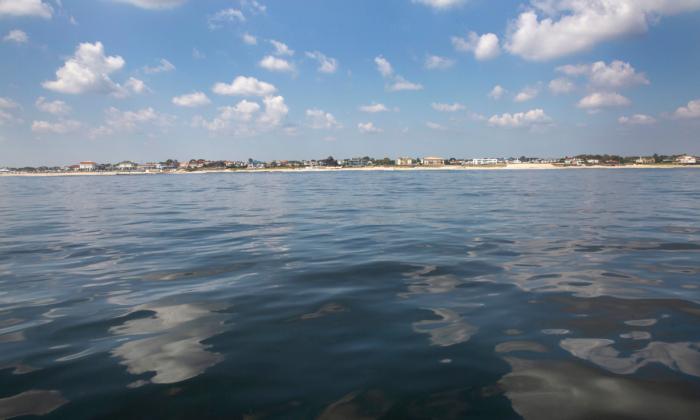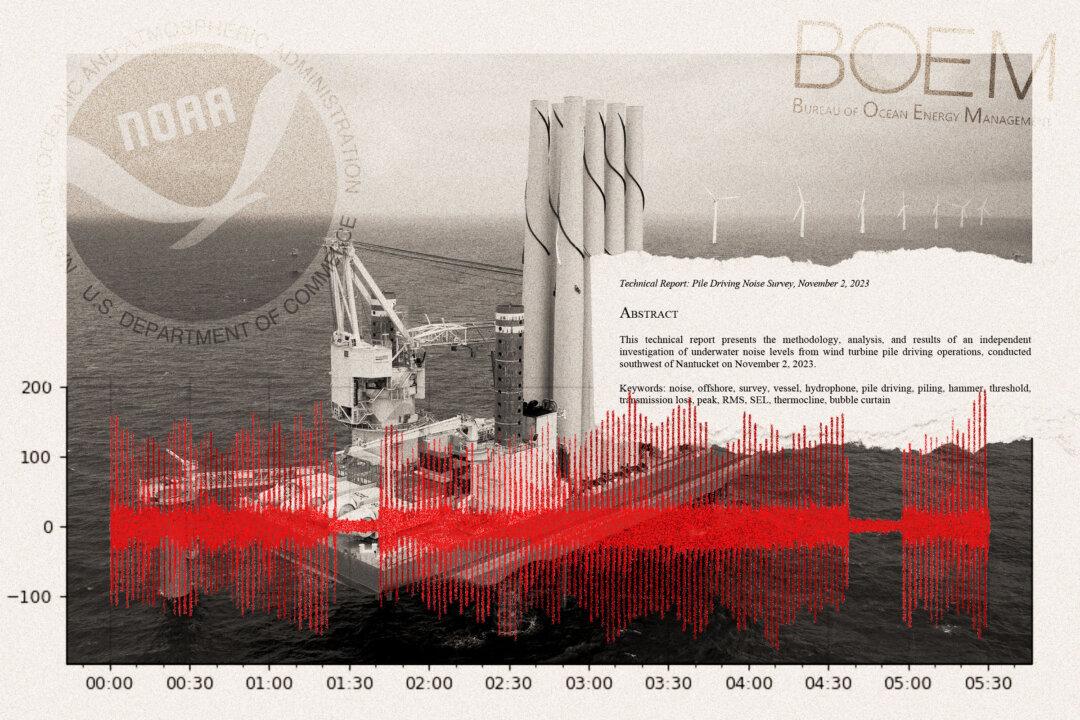Environmental groups are asking for a 90-day extension for public comments on an environmental review of the combined effect of six offshore wind farm leases sold by the Biden-Harris administration in February 2022.
Six companies paid a record $4.37 billion to build the wind farms over 488,000 acres of ocean in the New York Bight, a geological indentation on the eastern coast of the United States between New Jersey and New York.
The federal Bureau of Ocean Energy Management (BOEM) just released a 1,429-page analysis of environmental impacts that could be caused by the six wind farms and gave the public 45 days to comment in the Federal Register. The deadline is Feb. 26.
Cindy Zipf, executive director of Clean Ocean Action, an environmental coalition based in Long Branch, New Jersey, said her group is asking for a 90-day extension.
“This is a massive document in a massive area, with lots of studies referenced,” she told The Epoch Times. “To suggest that this could all be evaluated in 45 days is just ridiculous.”
Conducting an environmental assessment is good, Ms. Zipf said.
“The unfortunate thing is that it’s kind of happening at the end of the game when they’ve already sold the land. They’ve already decided that they’re going to build out there and now they’re doing an environmental assessment, which seems backward.
“It points to the recklessness in which this whole offshore wind massive development has been perpetuated,” Ms. Zipf told The Epoch Times.
“It’s shocking. Where was the planning? Where was the memo, the initial decision? And where was the public’s role in deciding that the ocean was just going to become a giant power plant?”
In announcing the Programmatic Environmental Impact Statement (PEIS) for the New York Bight, the bureau said: “This new regional approach is an evolution of BOEM’s process to help ensure timely decisions that advance offshore wind energy development while safeguarding the ocean environment and marine life and reducing conflicts with other ocean uses.”
Ms. Zipf is concerned that BOEM just wants to expedite the construction of the wind farms.
“The idea of these evaluations is to determine whether or not they should move forward,” she told The Epoch Times. “But it seems that that decision has already been made, and everything else is being wrapped around it in a way to provide some environmental oversight.”
Dr. Bob Stern, president of Save Long Beach Island, agreed. He worked for years in the Department of Energy, which includes BOEM, managing environmental impact statements.
“The term ‘programmatic’ is misleading,” Dr. Stern told The Epoch Times in an email. “This is not the kind of programmatic review that the National Environmental Policy Act calls for.
“A good programmatic Environmental Impact Statement (EIS) would look at the actual offshore wind program itself, and alternatives for turbine location, their number, and their power.
“This EIS just continues with the pre-selected projects and considers measures for mitigation and monitoring,” Dr. Stern said.
‘An Extraordinary Pocket of Ocean’

Cindy Zipf loves talking about the New York Bight. “It’s the indentation, the little triangle that’s created by the Jersey shore and the New York Long Island coast jutting out,” she told The Epoch Times.
“It creates this little pocket of ocean that is one of the most extraordinary areas in the world.”
Ms. Zipf explained that the Gulf Stream brings warm waters to the Jersey Shore and New York. Then in winter, the Gulf Stream moves further offshore and the colder waters of the Labrador Current come down.
“This is a rare area in the ocean, where we get warm water and cold water throughout the year,” she said. “So we get warm water species and cold water species.”
The New York Bight is visited by 33 species of whales and dolphins, one species of porpoise, four species of seals, and five species of sea turtles—out of only seven species of sea turtles on the planet. It’s filled with fish, invertebrates, and the life that depends on them, such as shore birds.
“It’s just an incredibly ecologically rich area that depends on wide open spaces, a quiet, dark ocean environment that they’ve evolved in over millions or billions of years,” Ms. Zipf said.
“People think the ocean is so big and so vast, how could we possibly do it harm,” she continued. “But we’ve done it in the past, and it looks like we’re on the verge of doing it again.”
Clean Ocean Action is a nonpartisan organization, with 35,000 people on its mailing list, that has been fighting for the ocean for 40 years.
The organization successfully campaigned to reduce plastics and litter that pollute waterways and spoil beaches, protect coasts from ocean oil and gas drilling, and reduce waterway toxins to ensure fish and shellfish are safe to eat.
“Our ocean off the New York and New Jersey coast was terrible in the ‘80s and ’90s,” Ms. Zipf told The Epoch Times.
“We worked really hard to restore it, and it is thriving, it is beautiful, and it is an economic engine for so many clean ocean economies.”
Clean Ocean Action is not opposed to responsible and reasonable offshore wind development that supports and sustains a healthy ocean, she said. But the group wants any development decisions to be supported by science, which so far has not happened. They also want to start with a pilot project.
Public Meetings on Environmental Impact
Not knowing if an extension to review BOEM’s New York Bight programmatic environmental impact statement will be granted, Clean Ocean Action is pushing ahead to analyze it and comment in the Federal Register.The bureau will hold two virtual and three in-person public meetings on the document: Jan. 31, 5 p.m. (virtual meeting); Feb. 5, 4 p.m. (North Dartmouth, Massachusetts); Feb. 7, 4 p.m. (Stony Brook, New York); Feb. 8, 4 p.m. (Toms River, New Jersey); Feb. 13, 1 p.m. (virtual meeting).
The format for the in-person meetings is structured like an open house. Attendees can visit information stations and talk with BOEM subject matter experts.
“It’s not a public hearing, in that same way where we’ve been accustomed to, being in a room together, looking the decision-makers in the eye,” Ms. Zipf told The Epoch Times.
“It’s a way that government now is avoiding the accountability sessions that should be a part of the democracy that we have.
“It’s a quirky process. The only thing I can say to it is that they do have to answer questions, which is a value.”
New York Pushes for New Wind Proposals
While the federal government is asking the public to comment on the environmental impact statement for the New York Bight, the state of New York is pushing ahead with its fourth competitive solicitation for offshore wind proposals.The New York State Energy Research and Development Authority (NYSERDA) created an expedited solicitation process—submission requirements were significantly streamlined and bid fees were reduced.
Bidders are required to hold BOEM offshore wind leases, but any project able to interconnect and deliver energy to New York State is eligible, according to a development authority spokesperson.
Developers that are currently under contract to the authority can re-bid their projects, adjusting their costs and economic benefits. Developers not under contract can also bid.
NYSERDA anticipates bids coming from lease areas across the New York Bight, the spokesperson said. Submissions are due on Jan. 25, and award announcements are expected to be made in February.
Clean Ocean Action wants a pause in the headlong rush to industrialize the ocean.
At the request of New Jersey Representative Chris Smith, in June 2023 the Government Accountability Office—and independent congressional watchdog—agreed to launch an investigation into the impacts of offshore wind development.
In the name of good governance, Ms. Zipf said, state and federal agencies should wait for the results.
“We feel very strongly that we haven’t done the work to prove that this massive industrialization is going to be the climate solution that it’s claimed to be,” she told The Epoch Times.
The ocean itself is an important buffer for climate change and needs to be protected, Ms. Zipf said. The massive wind farms are inconsistent with an ocean environment, but the ocean seems so vast and doesn’t scream in protest, so it is vulnerable to industrialization, she added.
“This is a scale of unimaginable size,” Ms. Zipf said. “It would never happen on land, and the ocean deserves the same or greater protection because it is such a life-sustaining force.”
“People need to be the voice of the sea,” she said.







